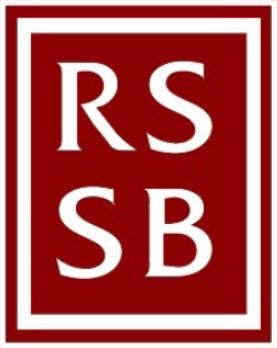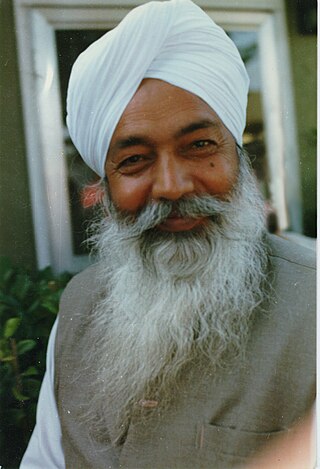The following outline is provided as an overview of and topical guide to spirituality:

Kirpal Singh was a spiritual master (satguru) in the tradition of Radha Soami.
Contemporary Sant Mat Movements, mostly among the Radha Soami tradition, are esoteric philosophy movements active in the United States, Europe, Australia, Latin America, and especially India. These movements assert that Sant Mat shares a lineage with Sikhism and contains elements of thought found in Hinduism, such as karma and reincarnation. They further assert that Sant Mat also contains elements found in Sufism and has inspired and influenced a number of religious groups and organizations. They refer to this spiritual path as the "Science of the Soul" or 'Sant Mat', meaning 'teachings of the saints'. More recently it has been described as "The Way of Life" or "Living the Life of Soul". It incorporates a practical yoga system known as Surat Shabd Yoga.
Surat Shabd Simran is a type of spiritual meditation in the Sant Mat tradition.

Radha Soami is a spiritual tradition or faith founded by Shiv Dayal Singh in 1861 on Basant Panchami Day in Agra, India.

Radha Soami Satsang Beas is a spiritual organisation in Radha Soami movement. It is headed by Gurinder Singh. The main centre of Radha Soami Satsang Beas is located on the banks of the Beas River in the northern Indian state of Punjab.

Thakar Singh was a spiritual teacher in the contemporary Sant Mat lineage of Sikh religious leaders.

Shiv Dayal Singh, known by the honorific "Param Purush Puran Dhani Huzur Soami Ji Maharaj" by his disciples and devotees, was an Indian spiritual guru and founder of Radha Soami, a 19th-century spiritual sect.

Sawan Singh, also known as The Great Master or Bade Maharaj ji, was an Indian Saint or Sant. He was the second spiritual head of Radha Soami Satsang Beas (RSSB) from the death of Jaimal Singh in 1903 until his own death on 2 April 1948.
Shabda, is the Sanskrit word for "speech sound". In Sanskrit grammar, the term refers to an utterance in the sense of linguistic performance.
Sant Mat was a spiritual movement on the Indian subcontinent during the 13th–17th centuries CE. The name literally means "teachings of sants", i.e. mystic Hindu saints. Through association and seeking truth by following sants and their teachings, a movement was formed. Theologically, the teachings are distinguished by inward, loving devotion by the individual soul (atma) to the Divine Principal God (Parmatma). Socially, its egalitarianism distinguishes it from the caste system, and from Hindus and Muslims. Sant Mat is not to be confused with the 19th-century Radha Soami, also known as contemporary "Sant Mat movement".
Julian P. Johnson (1867–1939) was an American surgeon and author of several books on Eastern spirituality. He spent much of 1932 to 1939 in India, was associated with the Radha Soami Satsang Beas spritual society and Surat Shabd Yoga, and wrote five books as a result of his experiences.

Charan Singh, was the spiritual head of Radha Soami Satsang Beas, Dera Baba Jaimal Singh, after he was named successor by the preceding Beas guru Jagat Singh, in 1951. Charan Singh served as the guru for the Beas Dera for almost four decades, until his death from heart failure in 1990 at the age of 73. Before his appointment in 1951, he had practiced law in Hisar and Sirsa, India. He was an initiate of Sawan Singh's, who was his paternal grandfather and the predecessor of Jagat Singh. Charan Singh assigned the duties of his successor and Guru to his initiate and nephew Gurinder Singh.

Gurinder Singh Dhillon, also known as Baba Ji to his followers, is the spiritual head of Radha Soami Satsang Beas (RSSB). He succeeded Charan Singh, his uncle, in 1990. The headquarters of this spiritual community, called Dera Baba Jaimal Singh, are located beside the river Beas near the town of Beas, Punjab, in northern India, and have been a centre for Satsang since 1891. RSSB has centres located worldwide.

Ajaib Singh, also known to his disciples as 'Sant Ji' was born on September 11, 1926, in Maina (Mehna), Bhatinda district, Punjab, India.

Jagat Singh (1884–1951) was an Indian spiritual leader and the head of Radha Soami Satsang Beas. He served as the guru for Beas Dera for three years, until his death in 1951 at the age of 67. He worked as a college chemistry professor at an Agricultural College and was honoured for his service by the British as Sardar Bahadur. After retirement he was chosen by his spiritual master to be his successor, becoming the third spiritual head of Radha Soami Satsang Beas. Jagat Singh assigned the duties of his successor and guru to his initiate Charan Singh.

Sirio Carrapa is an Italian teacher and practitioner of mysticism and Surat Shabd Yoga in the Sant Mat tradition. He was a disciple of Kirpal Singh and Ajaib Singh, and he is acknowledged as a spiritual Master, carrying on the work of his Masters.
This is a list of gurus who gave teachings about the Path of Sound.
Ghoman or Ghuman is a village in Tehsil Sri Hargobindpur of Gurdaspur district of Punjab, India.
Satsang is an audience with a Satguru for religious instruction.










